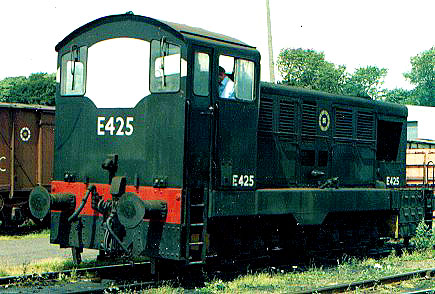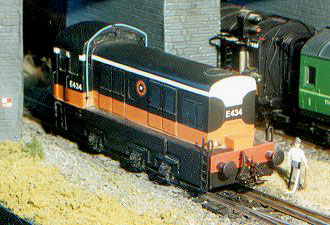Steve Johnson Modelmaker
|
CIE E421 Class The Prototype
In the mid 1950's, CIÉ decided it needed some shunting/transfer locomotives. These were designed in house and became known as the E401 Class. Nineteen locomotives built between 1956 and 1958. They used the Maybach MD220 diesel engine which developed 420bhp. Power was transmitted to the six wheels by a Mekydro KL64 torque converter. Although six wheeled, they have an unusual wheelbase of 4ft 11 11/16in x 8ft 0 5/16in. All wheels are driven by the torque converter, so that they have the somewhat rare wheel formation of 'C'. The top speed of these locomotives was originally quite high at 60mph, but the odd wheel spacing and consequent bad riding led to them being limited to 25mph. In 1962, a further batch of fourteen locomotives were built. This batch differed slightly from the E401 Class and were designated E421 Class. The E421's used a Mekydro KL64U torque converter and had a revised exhaust silencer routing, with the large silencer cowling being ommitted from the bonnet top. Both classes had been withdrawn by 1983. Three of the E421 Class have been preserved. The Model
At the time I built these, only one model had been offered. Sold as a kit to make both types, Q Kits made a cast resin body kit many years ago. These are no longer available. Fortunately, I has managed to obtain two of these kits and have made a model of both the E401 and E421 types. The body finish is typical of early cast resin types, lacking in crisp detail. Although sold as a kit to make both types, the Q Kits version was really an E401 Class with an optional exhaust cowling. Although basically the same, the E421's are longer at 31ft 4¼in as opposed to the E401's length of 29ft 4¼in. Most of this extra length is taken up with longer cab and an extended running plate in front of the bonnet. As already mentioned, the body supplied was not quite right for the E421 Class, so a few modifications were needed. The cab needed to be lengthened, so this was achieved by cutting the cab in half through the centre of the side windows. A new piece of plasticard was let into this gap and the two halves fixed together. The joint was made good by careful filling and smoothing down. The running plate needed to extended forward. A plasticard 'box' of the correct dimensions was constructed and fitted onto the front of the existing buffer beam. The small box that sits on top was also made from plasticard and secured into position. As the E421's do not have the exhaust cowling, CIÉ fitted an extra set of windows, so these had to be carefully filed out. The sideframes were then added, with the gaps at either end being made good. Fitting of the buffers, handrails front steps and coolant filler pipe added. The air horn is a very short trumpet type mounted between the cab windows on top of the bonnet. An ordinary diesel air horn was used but suitably cut down first. My E421 also ended up in the Golden Brown/Black/White livery with the numbers once again being Letraset and the CIÉ orange roundal from Mabex. My own version of flush glaze was added before turning to the chassis. The Chassis The chassis caused a bit of a problem at first, no-one did a 13ft wheelbase bogie, or a 4ft 11 11/16in for that matter. However, Tenshodo did produce a 31mm wheelbase Spud. So I constructed a chassis using the Spud at the rear to cover the 8ft spaced wheels and a non-driven set at the nose end. The locomotive does not look too bad, but for the new and improved 21mm gauge P4 layout, something better is needed. The 3D printed bodies made by Valve Design and available via Shapeways may be the answer.
|
|

